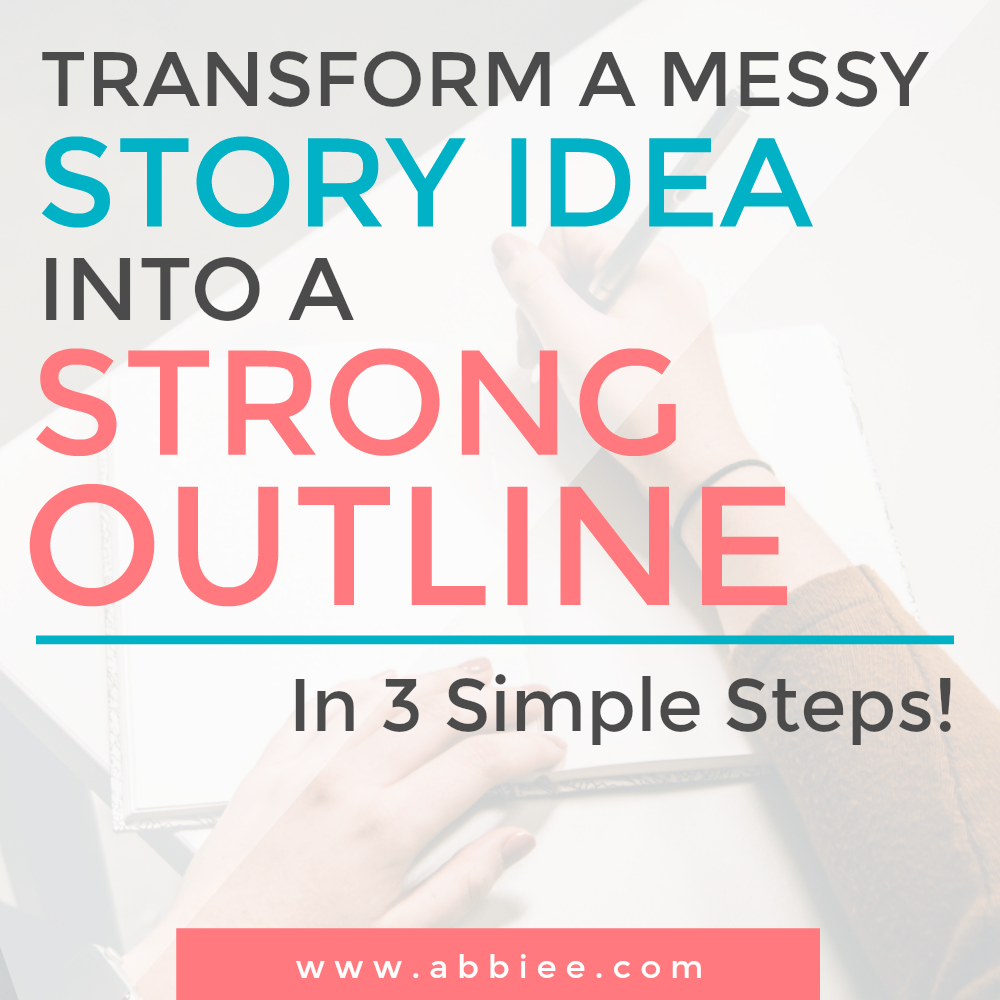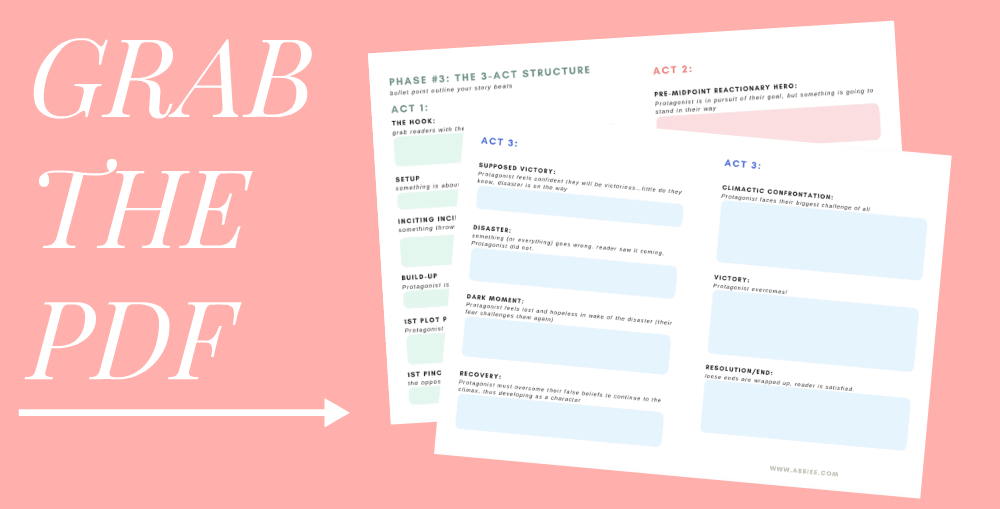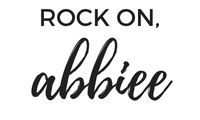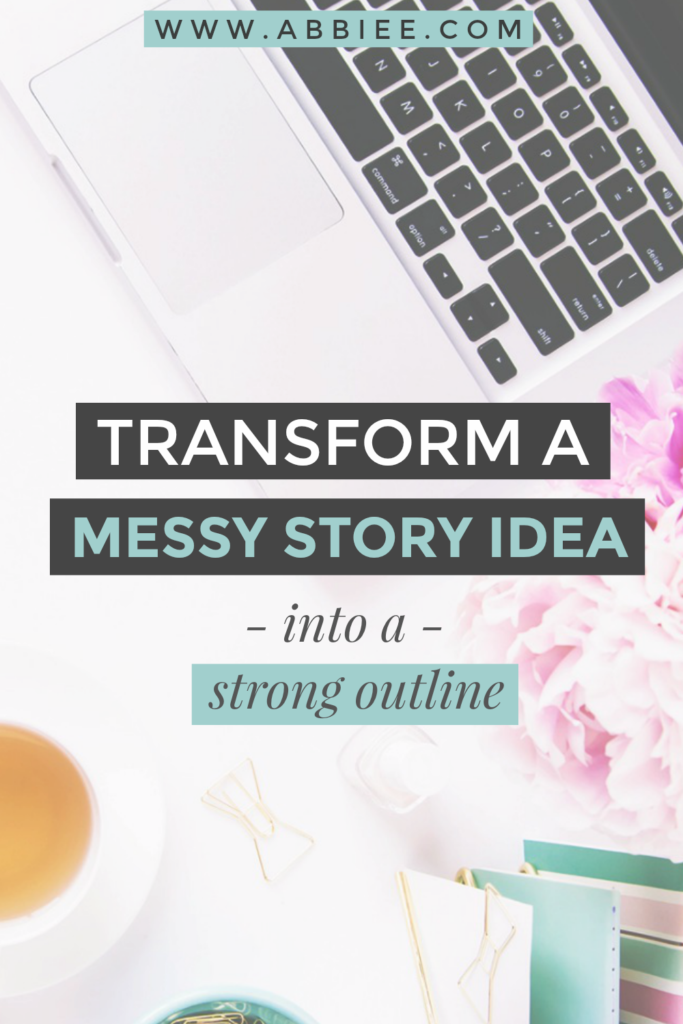
If you know me at all, you know that plot bunnies frequently attack me. I get so many story ideas, I can hardly keep track of them. And I know a lot of other writers who struggle with this too. But when it comes to turning those messy ideas into real novels…YIKES.
I mean, where do you even start? That’s the problem. You have this brilliant “pinprick” of an idea — a premise, a theme, maybe just one word — but you’re not sure where to go from there.
How do you transform a little messy plot bunny (that keeps you awake at night) into a strong outline for an actual novel? That’s the question we’re going to answer today. I’m going to show you my exact process for taking an idea and turning it into a small but strong outline.
I’m a plotter which means once I have an outline, I CAN DO GREAT THINGS. You might be a pantser and hate outlining, but I assure you, it’s going to help you SO MUCH in the long run to have a brief outline — even if it’s vague. It will keep you on track and ensure you write a story that’s riveting enough to keep readers hooked to see what happens next.
Ready? LET’S HOP TO IT.

First, figure out the premise.
You probably already have a rough idea of this, seeing as that’s what a “plot bunny” essentially is. Hopefully you’ve already written down your ideas* but if not, do that. Just start with “what if” and brain-dump your idea, however messy it is. MESSY IS OKAY AT THIS POINT.
Also, it’s perfectly fine to NOT know the premise of your novel. Like I said before, your plot bunny might just be a mysterious wisp of an idea — a feeling, an image, a word. Think of it as a writing prompt.
*don’t just “keep them in your head” as my sister does please it keeps me up at night

Next, meet your protagonist.
Characters are the most important part of storytelling. Why? Because story is not about what happens; it’s about how what happens affects and transforms the characters. If you can get someone to fall in love with your characters and relate to them, they will be hooked and want to read everything that happens to those characters — whether it’s a trip to Starbucks or a voyage across the galaxy. And that’s why before you start doing ANYTHING with your plot, you need to meet your protagonist.
This is just going to be a rough outline, so you don’t need to dive too deep into developing your protagonist yet. But you should figure out a few basic things about them that will hugely impact the story:
- their desire (the thing they want + think will make them happy)
- their fear (the thing stopping them from going after the thing that will make them happy)
- their misbelief (the thing they mistakenly believe is true about the world, which feeds off their fear)
These are always the first three things I sketch for my protagonist when I start outlining a novel. Because over the years I’ve learned: this is the lifeblood of storytelling. This is the thing your reader is subconsciously searching for: an internal journey, leading to an “aha” moment, which will put to death a misbelief the protagonist has been holding onto all their life.

Finally, grab a 3-act story structure.
Like I said before, I’m an insane plotter. I outline my book three times (each outline being twice as long as the one before it lol) before I actually sit down and write the book. BUT YOU DON’T HAVE TO BE THAT CRAZY. Today, we’re just going to get the skeleton of your story down.
The first time I outline my story, I just want the skeleton. So I use the 3-Act Story Structure* and go through it really fast (bullet point style) so that I can see from a bird’s eye view where the pivotal moments of my story take place. This is the template I use:
*I’ve researched other story structures, but the 3-act is my favorite because SO MANY of my favorite stories follow this structure and it feels natural, satisfying, and just GOOD.
BASIC 3-ACT STORY STRUCTURE:
ACT 1
The Hook: grab readers with the inner conflict of Protagonist
Setup: something is about to happen to Protagonist, reader can feel it
Inciting Incident: something throws Protagonist outside their comfort zone
Build-up: Protagonist is going to have to face this thing head on
1st Plot Point: Protagonist makes a decision which determines what will happen next
1st Pinch Point: the opposition/antagonistic force looms in the distance
ACT 2
Pre-midpoint Reactionary Hero: Protagonist is in pursuit of their goal, but something is going to stand in their way
Midpoint: plot twist! everything changes
Post-midpoint Action Hero: thanks to the game-changing midpoint, Protagonist has to switch gears when it comes to their goal
2nd Pinch Point: Antagonist gets closer to disrupting Protagonist’s life
ACT 3
Supposed Victory: Protagonist feels confident they will be victorious…little do they know, disaster is on the way
Disaster: something (or everything) goes wrong. reader saw it coming, Protagonist did not.
Dark Moment: Protagonist feels lost and hopeless in wake of the disaster (their fear challenges them again)
Recovery: Protagonist must overcome their false beliefs to continue to the climax, thus developing as a character
Climactic Confrontation: Protagonist faces their biggest challenge of all
Victory: Protagonist overcomes!
Resolution/End: loose ends are wrapped up, reader is satisfied.

But isn’t this too…predictable?
That’s what I was worried about when I first read about story structures. If everyone followed this story structure, wouldn’t we just be able to GUESS what happens next and thus lose all interest in the story?
Short answer: no.
Long answer: think about it. Hundreds of successful stories have followed this structure and garnered millions of avid fans from all walks of life. Why? Because it’s not so much a question of “what’s going to happen?” for the reader. It’s a question of “HOW is it going to happen?” When your protagonist majorly messes everything up, the reader isn’t saying “I wonder if he’s going to fix everything and actually come to his senses,” more often, the reader is saying: “I wonder HOW he’s going to fix everything and come to his senses.”
We can often predict the endings of stories. We do this all the time when we watch movies. “I know this has a happy ending,” we say — but in the midst of the story’s conflict, we can’t see HOW this mess is going to turn out happily-ever-after. That’s where the intrigue comes in. And that’s what keeps us up past our bedtime.
To make sure we’re all tracking, I’m going to show you an example of the 3-act story structure filled out with just one of the many stories that follow this structure: Jane Eyre.
THE 3-ACT STORY STRUCTURE OF JANE EYRE:
[spoilers ahead!]
ACT 1
The Hook: Jane Eyre is a penniless orphan child left to the care of her cruel aunt, who sends her away to school.
Setup: Jane grows up without love or a home, leaving her no destiny but to become a governess when she’s old enough.
Inciting Incident: Jane takes a position as governess and goes to Thornfield Hall.
Build-up: Jane is eager to meet Mr. Rochester, the master of Thornfield (and so is the reader.)
1st Plot Point: Rochester arrives on the scene and throws Jane’s world off-axis. He’s going to change everything for her.
1st Pinch Point: Jane observes clues that Thornfield holds a secret. Blanche Ingram, Rochester’s lady friend, sparks jealousy in Jane.
ACT 2
Pre-midpoint Reactionary Hero: Jane, always in pursuit of love but feeling herself unworthy of it, finds herself more attracted to Rochester than ever.
Midpoint: Rochester professes his love for Jane and she accepts his proposal of marriage.
Post-midpoint Action Hero: Thanks to the proposal, Jane’s whole life has changed. She feels loved for the first time in her life.
2nd Pinch Point: Jane has a disturbing dream that leaves her shaken. She senses that the house — and Rochester — holds a secret.
ACT 3
Supposed Victory: Jane and Rochester are this close to tying the knot, when—
Disaster: The secret comes out: Rochester has a wife already, a lunatic who lives at Thornfield.
Dark Moment: Jane feels betrayed and hopeless — her fear and misbelief of never being loved returns to challenge her. She leaves Rochester and Thornfield, bound for nowhere.
Recovery: After being rescued by her long-lost cousins, Jane must overcome her misbelief and realize that she is loved — Rochester loves her, and he needs her.
Climactic Confrontation: Jane returns to Thornfield, only to find it burned and in ruins. There was a fire, which cost Mr. Rochester his eyesight and Mrs. Rochester her life.
Victory: Jane finds Rochester and promises to never leave his side.
Resolution/End: AND THEY ALL LIVE HAPPILY EVER AFTER.
There it is — how Charlotte Brontë would have outlined Jane Eyre if she was using the 3-act story structure. This is why I love making my initial outline like this — because you can really SEE where the story is headed and know right away where the problem areas are and how to fix them. It’s so fast and easy!! And, for me, it usually sparks tons of new brilliant ideas.
GOOD NEWS
I designed a printable for you! It’s the 3-act story structure but BETTER because it’s a template for YOUR story. It will walk you through this whole process so that you can effortlessly transform your messy plot bunny into a strong outline — and then, turn it into an actual novel! Grab the PDF here.

TALK, BRO
Do you use the 3-act story structure to outline your books? What is your favorite way to outline a story? Do you have WAY TOO MANY plot bunnies like I do?? Let’s talk writing in the comments below.

LOVE THIS POST? PIN IT!




